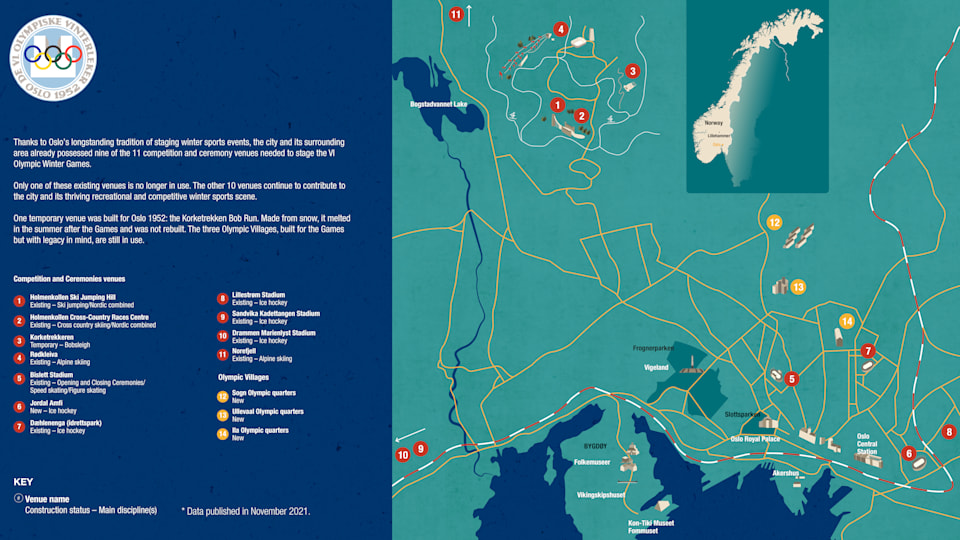Oslo 1952: Overview
Thanks to Oslo’s long tradition of staging winter sports events and its flourishing recreational and competitive winter sports scenes, nine of the eleven competition venues used for the Olympic Winter Games Oslo were pre-existing sites. Of the other two venues, one was built for the Games, and the other was temporary.

One temporary venue was built for Oslo 1952: the Korketrekken Bob Run on Frognerseteren hill. Built with snow and ice, this natural run was never used for bobsleigh again after the Games but was turned into a luge run as planned, hosting the 1955 Luge World Championships. The track was not rebuilt after this.
Among the other ten permanent (newly built or pre-existing) venues, nine are still in use and remain integral to grassroots and high-performance sport in the Oslo area.
The one venue built specifically for the Games was the Jordal Amfi stadium, the setting for most of the ice hockey matches. Designed as a multi-purpose facility to ensure its use all year round, it was rebuilt in 2017 as the New Jordal Amfi, a state-of-the-art ice rink.
The remaining ice hockey matches were staged at Dæhlenenga Idrettspark, Kadettangen, Marienlyst Stadium and Lillestrøm Stadium, sporting facilities that all remain in use. Kadettangen and Marienlyst are both home to football teams competing in Norway’s top two divisions.
The Bislett Stadium, the venue for the Opening and Closing Ceremonies and the figure skating and speed skating competitions at Oslo 1952, is synonymous with track and field and hosts the prestigious Bislett Games every year. The stadium was first constructed in 1922 and was rebuilt in 2004. The new Bislett Stadium, built in the same unique architectural style as its predecessor, opened the following year.
Boasting a history that dates to 1892, Holmenkollbakken hosted the ski jumping events at Oslo 1952 and is one of Norway’s most iconic sporting facilities. Redeveloped on 18 separate occasions, most recently in 2008, it continues to host World Cup competitions, world championships and national and local events.
The Alpine skiing events at Oslo 1952 were staged at Rødkleiva (slalom) and Norefjell (downhill and giant slalom). Rødkleiva is now better known for its off-piste skiing, after the hill used at Oslo 1952 closed in 1988. Ninety minutes from the capital, Norefjell is a small ski resort with state-of-the-art lifts and snowmaking equipment that guarantees snow all winter long. It also has a luxury spa and aparthotel complex, making it a popular year-round destination.
The athletes and coaches participating at Oslo 1952 stayed at three Olympic Villages across the city, all of which met housing needs after the Games. The Olympic Village in Sogn now houses around 1,500 students, while the buildings erected in the district of Ila provide accommodation for senior citizens. The two eight-storey blocks built at Oslo University Hospital in Ullevål offer living quarters for hospital staff and students.
Built to accommodate reporters and photographers attending the Games, the 343-room Hotel Viking was the largest in Scandinavia at the time and served as the main press centre. Refurbished on several occasions since then, it reopened in 2019 as Clarion Hotel the Hub, with interiors inspired by its 1950s roots.